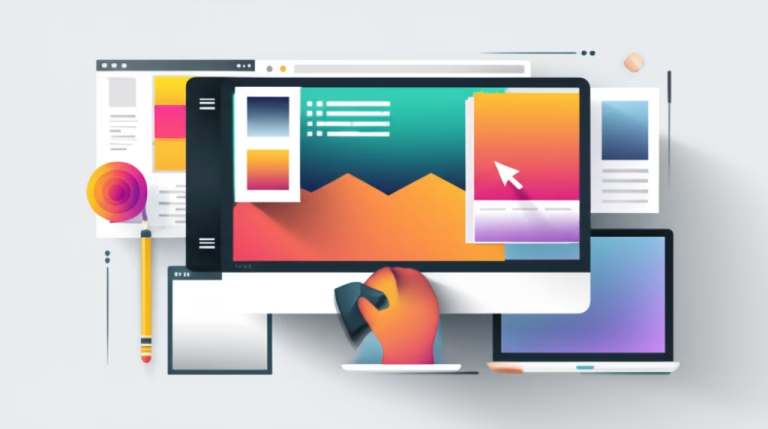Okay, aspiring designers! It’s time to talk about something super important for your journey: building a design portfolio that doesn’t just sit there, but truly *pops* and gets noticed. Think of it as your personal gallery, showcasing your talent and potential to the world. Whether you’re aiming for your first design gig or just want to share your creative passion, a strong portfolio is your best friend. This guide will walk you through making yours shine, even if you’re just starting out.
Table of Contents
The Challenge Every Designer Faces
Starting out in the world of design can feel overwhelming, right? You’ve been learning, practicing, maybe even creating some cool projects. But then comes the big question: how do you actually show what you can do to potential clients or employers? This is a challenge every designer, especially beginners, has to tackle. You need a way to present your skills and creativity clearly and effectively.
Without a clear way to showcase your work, it’s hard to stand out. How do people know about your unique style or your problem-solving abilities? This is where a compelling design portfolio comes in. It’s more than just a collection of images; it’s your introduction, your visual resume, and your chance to make a memorable first impression. Building one that truly “pops” can open doors you didn’t even know were there.
The Science Behind Building a Standout Portfolio
Why is a well-crafted portfolio so powerful? It taps into fundamental psychological principles. When someone views your portfolio, they’re not just looking at designs; they’re forming an impression of you as a designer. They’re evaluating your taste, your skill level, and your potential based on the visual story you tell. A great portfolio uses visual appeal and clear presentation to build trust and demonstrate competence almost instantly.
Think about it: humans are visual creatures. We process images much faster than text. A portfolio allows you to communicate your abilities powerfully through visuals. By presenting your projects thoughtfully, you guide the viewer’s perception, highlighting your strengths and making your work memorable. It’s about creating an experience that resonates and makes them want to learn more about you and your design journey.
Fundamental Principles
Curation: The first key principle is choosing the right pieces to show. You don’t need to include everything you’ve ever created. Instead, select your strongest and most relevant projects. Think quality over quantity. Each piece should serve a purpose and contribute positively to the overall impression of your design portfolio.
Storytelling: Simply showing finished designs isn’t enough. You need to tell the story behind each project. Explain the problem you were trying to solve, your process, your decisions, and the outcome. This shows your thinking and problem-solving skills, which are just as important as the final visual result. A good narrative makes your work more engaging.
Presentation: How you present your work matters immensely. Your portfolio itself should be well-designed, easy to navigate, and visually appealing. High-quality images, clear project descriptions, and a consistent look and feel across your portfolio platform are essential for making a strong impact and showcasing your professionalism.
Practical Strategies for Your Portfolio
- Start Small: When to use: You’re a beginner designer and don’t have client work yet. How to apply: Showcase personal projects, passion projects, mockups, or re-designs of existing brands. These demonstrate your skills and creativity just as effectively.
- Focus on Quality, Not Quantity: When to use: You have a lot of projects, but not all are equally strong. How to apply: Be selective. Choose only your absolute best pieces, ideally between 3 and 7 to start. A few stellar projects are better than many mediocre ones.
- Show Your Process: When to use: You want to demonstrate your thinking and problem-solving skills. How to apply: For each project, include sketches, wireframes, mood boards, or different iterations. Explain your rationale behind key design decisions. This adds depth.
- Tailor Your Portfolio: When to use: You are applying for specific types of design roles or attracting particular clients. How to apply: Create different versions or sections of your online portfolio that highlight projects most relevant to the opportunity. This shows you understand their needs.
Real Cases: When Portfolios Go Wrong
Learning from mistakes is a crucial part of growth. Seeing where others have stumbled can help you avoid the same pitfalls when building your own portfolio. These real-world examples highlight common issues that can prevent your talent from shining through and hinder your progress in your design career.
Case 1: The “Everything Including the Kitchen Sink” Portfolio
Problem: A designer includes every single piece of work they have ever created, regardless of quality or relevance. The portfolio is massive, inconsistent, and overwhelming for the viewer. It becomes difficult to discern the designer’s true skill level or area of focus amidst the clutter. The best pieces get lost in the noise.
Lesson: Be ruthless in your selection. Your portfolio is a curated collection, not an archive. Only showcase your strongest work that represents the kind of design you want to do. Less is often more. Make it easy for viewers to see your best capabilities quickly.
Case 2: The “Mystery Box” Portfolio
Problem: The portfolio displays only the final images of projects with no context, explanation, or description. The viewer sees a nice picture but has no idea about the project’s goals, the designer’s role, the challenges faced, or the thinking behind the design. It’s visually appealing but lacks substance.
Lesson: Every project in your portfolio needs a story. Explain the brief, your process, the decisions you made, and the outcome. This demonstrates your ability to think critically and solve problems through design. Show the journey, not just the destination.
Case 3: The “Broken Link” Portfolio
Problem: The designer sets up an online portfolio, but links are broken, images don’t load, or navigation is confusing. This creates a frustrating experience for anyone trying to view the work and reflects poorly on the designer’s attention to detail and professionalism, even if their design work itself is good.
Lesson: Treat your portfolio platform with as much care as your design projects. Ensure everything is functioning correctly, images are optimized, and the user experience is smooth. Regularly check for broken links or display issues. A polished presentation is key to making a good impression.
Your Action Plan for a Popping Portfolio
Ready to build a portfolio that truly reflects your potential? Here’s a simple action plan to get you started and keep you moving forward. Remember, building a great portfolio is a continuous process, not a one-time task. Take it step by step, and celebrate your progress along the way.
- Today: Gather all your existing design work in one place. This could be files on your computer, old school projects, personal experiments, or anything you’ve created that you feel shows your design skills, no matter how small. Just collect everything for now.
- This Week: Review everything you’ve gathered. Select 3 to 5 of your strongest pieces that you are most proud of and that best represent the type of design work you want to do. These will be the foundation of your initial portfolio. Don’t worry about having too few; focus on quality.
- This Month: Choose an online portfolio platform (like Behance, Dribbble, or build a simple website on platforms like WordPress or Squarespace) and create your account or set up your site. Upload your chosen projects and start adding descriptions. Focus on clear visuals and basic project context.
- Next 3 Months: Refine your project presentations. Write detailed case studies for each piece, explaining your process and thinking. Seek feedback from other designers or mentors. Actively add new work as you create it and continue to refine your selections. Use your portfolio to actively showcase design work to others.
Clear Your Doubts about Your Portfolio
It’s natural to have questions when you’re building your first design portfolio. Here are some common doubts aspiring designers have and straightforward answers to help you move forward with confidence. Don’t let uncertainty hold you back from showcasing your talent.
Q: Do I need professional experience to have a portfolio?
A: Absolutely not! Personal projects, school assignments, and even hypothetical projects are perfectly valid for your portfolio, especially when you’re starting your design career.
Q: What is the best platform to host my online portfolio?
A: There’s no single “best.” Platforms like Behance and Dribbble are great for visibility, while a personal website offers more control over branding and presentation. Choose one that fits your needs and technical comfort level.
Q: How many projects should I include in my portfolio?
A: Start with 3-5 strong projects. As you gain more experience and create more work, you can expand to 8-12 projects. Focus on showcasing your best work, not every single piece you’ve ever done.
The Next Step in Your Journey
Building a portfolio that pops is a significant step in your design journey. It’s your opportunity to visually communicate your skills, passion, and potential to the world. By curating your best work, telling compelling stories about your process, and presenting everything beautifully, you create a powerful tool for your growth and your career.
Keep creating, keep refining, and keep adding to your portfolio. It’s a living document that evolves with you as a designer. Use it actively to connect with opportunities and share your unique creative voice. Your journey to building an impressive body of work has just begun!
Deepen your knowledge by reading our article about Design Demystified for Beginners!



